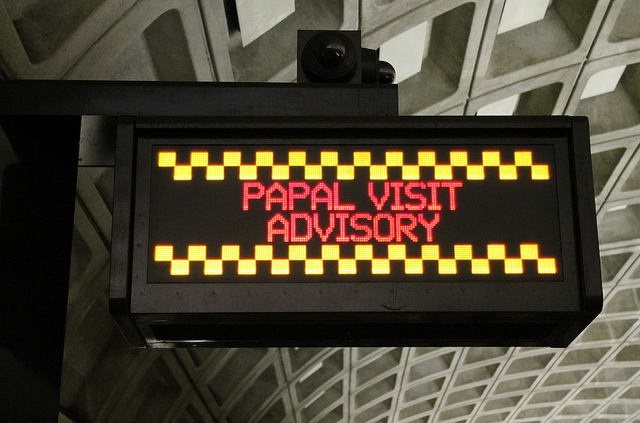
Since his election in March 2013, Pope Francis has gained attention for his efforts to refocus the Catholic Church on issues of social justice. His recent visit to the U.S. was met with acclaim from religious leaders and political liberals, but also sparked consternation among cultural and political conservatives. U.S. Rep. Paul Gosar (R-AZ), a Catholic himself, boycotted Francis’s address to Congress and accused him of adopting “socialist talking points presented to guilt people into leftist politics.”
The cultural divisions within American Catholicism exposed by Pope Francis’s visit are not new. While Gosar may be more vocal than most conservative Catholics, his protest reveals a split between interpretations of the Catholic faith that have been simmering for generations.
- Andrew Greeley. 1979. “The Sociology of American Catholics.” Annual Review of Sociology 5:91–111.
Mary Ellen Konieczny shows that the narratives American Catholics use to construct their religious identities have profound political consequences. Some congregations use the language of community to structure their worship, while others structure their activities around the concept of family. In parishes where community talk is dominant, social justice is usually the focus of ministry, but in congregations where family is the main narrative, concerns about personal and sexual morality get more attention. Neither model is more Catholic than the other: both types of congregations draw upon doctrines and use ritual practices central to the Catholic tradition. Hence, the variation Konieczny observes has less to do with texts or doctrines than with the ways people interact in group settings.
- Mary Ellen Konieczny. 2013. The Spirit’s Tether: Family, Work, and Religion among American Catholics. Oxford University Press.
The ideological divide in Catholicism also has historical roots in the relationships between the papacy and states. Gene Burns argues that as European states liberalized in the 19th century, Popes struggled to retain political influence for the church. Attempts to engage questions of poverty were seen as intrusions into government affairs, but through discussions of personal morality, the Church could carve out a space where its authority still dominated. As a result, the Church’s ideological emphases turned toward sexual morality and family issues, while sociopolitical concerns grew peripheral.
- Gene Burns. 1990. “The Politics of Ideology: The Papal Struggle with Liberalism.” American Journal of Sociology 95(5):1123–52.
The postwar period saw a revitalization of Catholic religious activity in the politics of economic justice. Jose Casanova shows how the Solidarity movement in Poland and letter-writing campaigns among American nuns after Vatican II helped to steer church activity back toward social justice work, and John O’Brien charts the influence of labor activist-priest George G. Higgins on Catholic social thought in the 20th century.
- Jose Casanova. 1994. Public Religions in the Modern World. Chicago, IL: University Of Chicago Press.
- John O’Brien. 2004. George G. Higgins and the Quest for Worker Justice: The Evolution of Catholic Social Thought in America. Lanham, MD: Sheed & Ward.
Pope Francis’s return to social justice issues does not necessarily make him a “liberal” pope. We might better view him as interested in returning the Catholic church to a language of social justice, firmly rooted in Church history, despite being obscured by previous Popes’ focus on other issues.

Comments